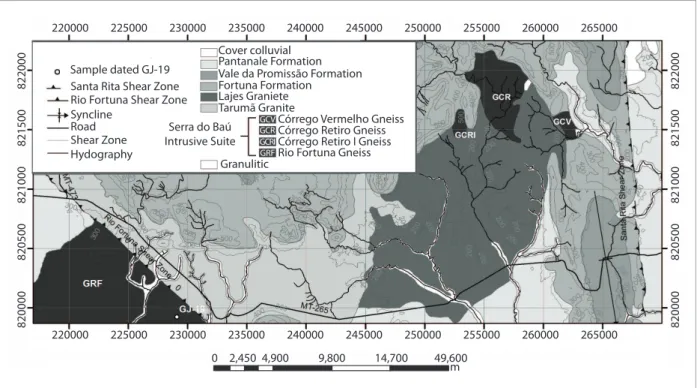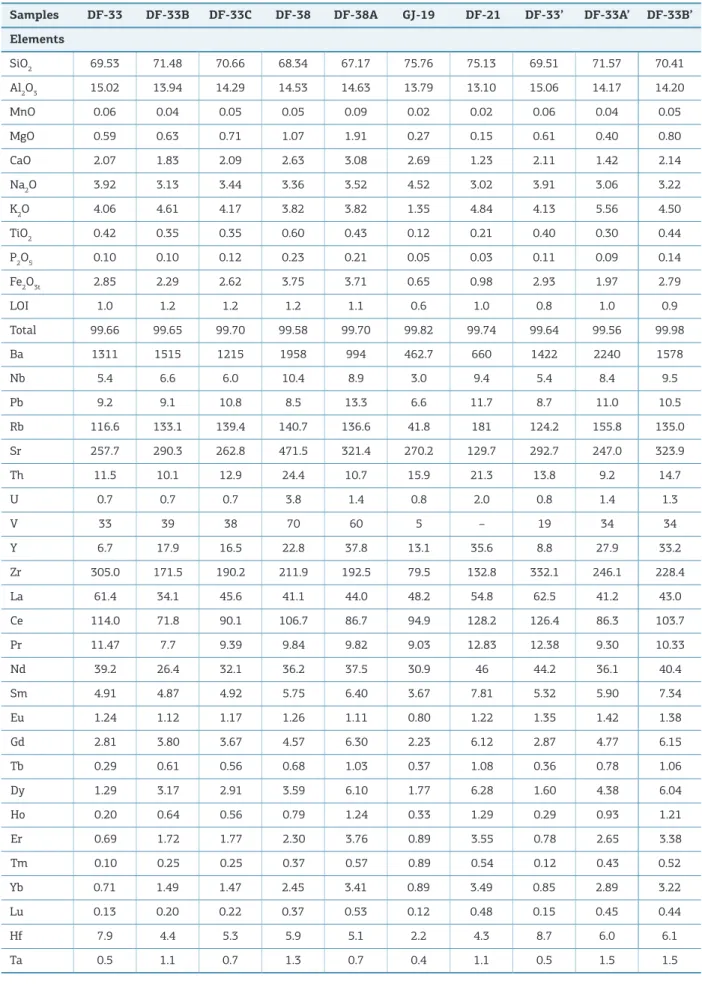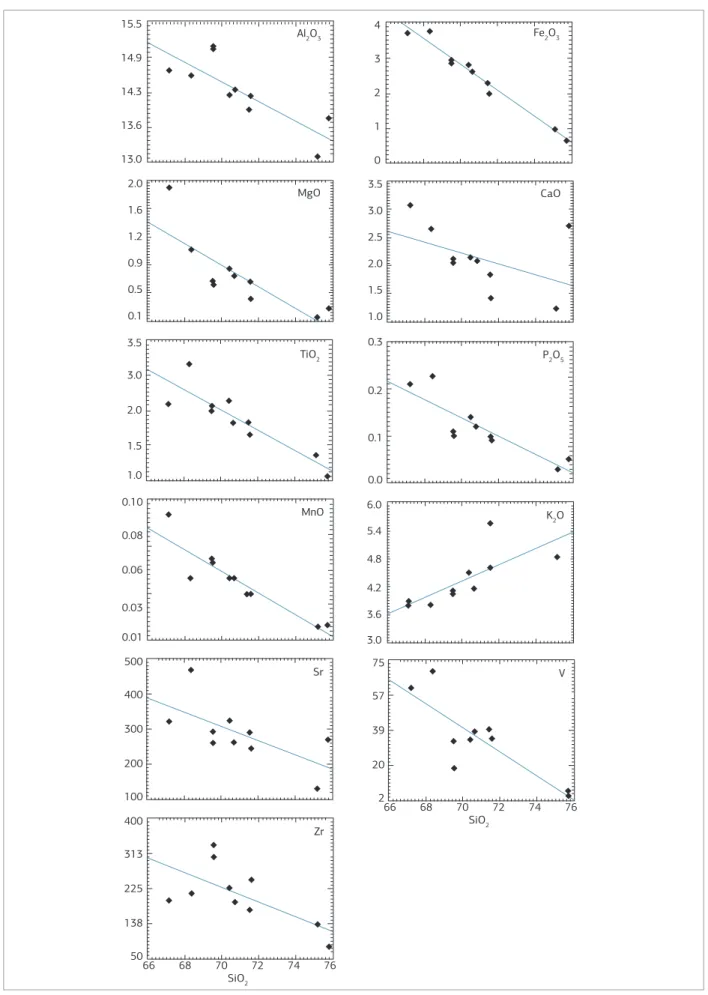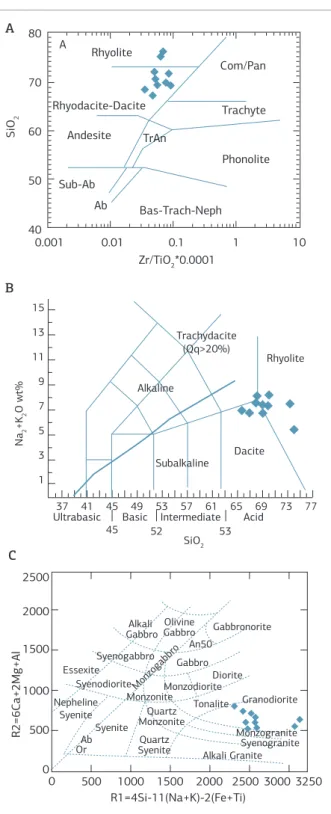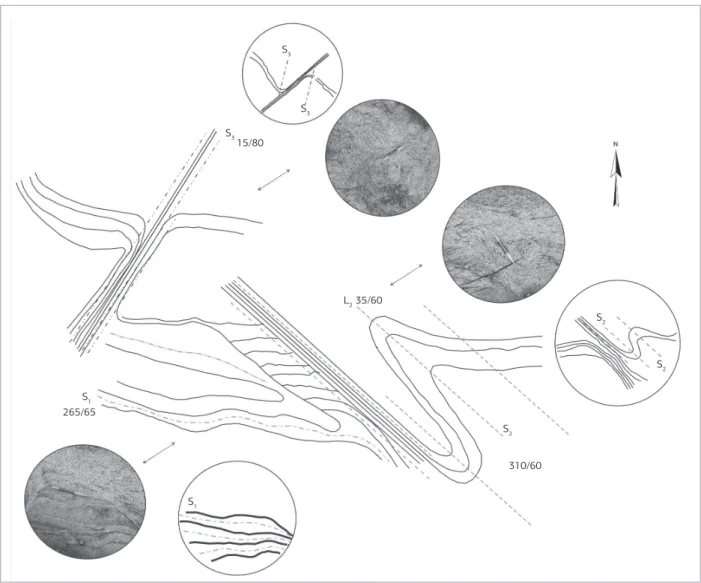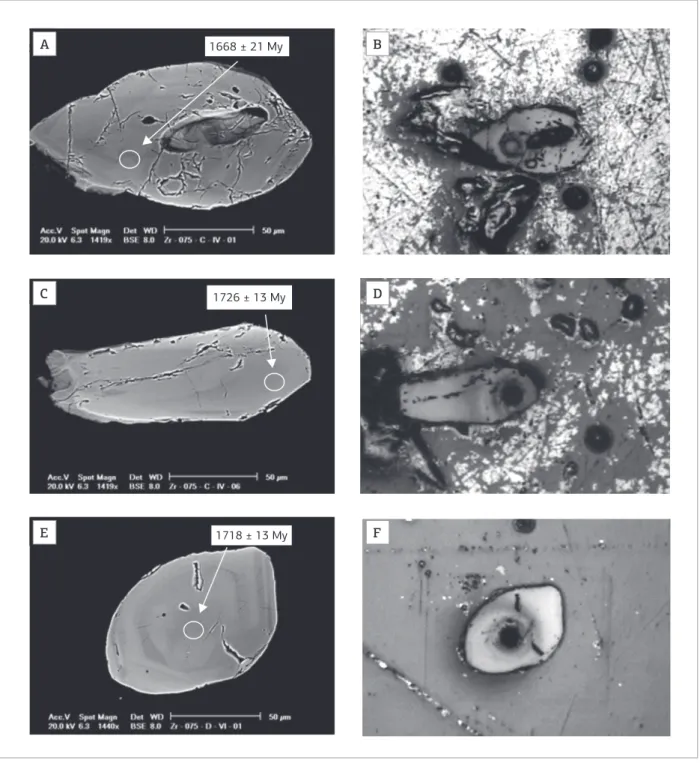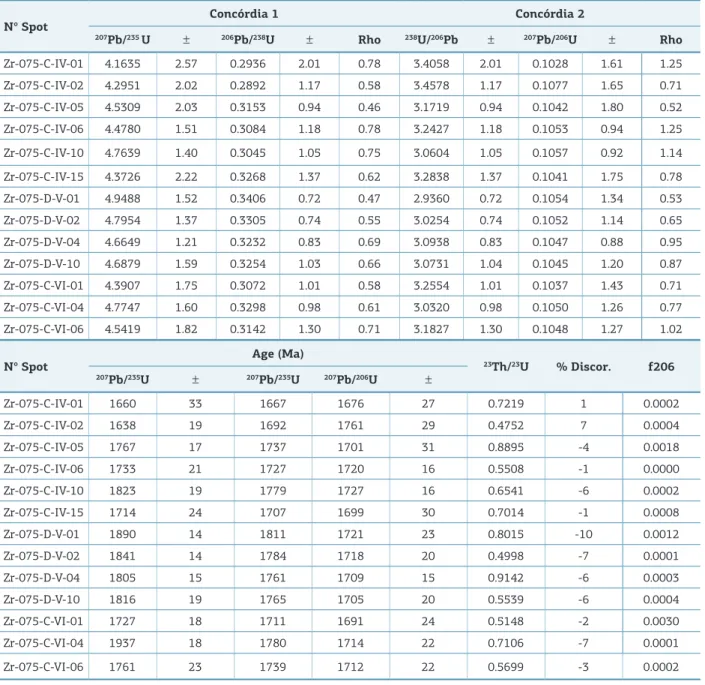1Research Group on Crustal and Tectonic Evolution, Guaporé (RS), Brazil. E-mail: defaal.debora@gmail.com; gabilimagel@gmail.com; asruiz@gmail.com; jmatos@ufmt.br; prof.mzaguiar@gmail.com; moamac@ufpa.br
2Post-Graduate Program in Geosciences, Instituto de Ciências Exatas e da Terra -ICET, Universidade Federal de Mato Grosso - UFMT, Cuiabá (MT), Brazil. Instituto Nacional de Ciência e Tecnologia de Geociências da Amazônia - GEOCIAM, Belém (PA), Brazil.
3Department of General Geology, Instituto de Ciências Exatas e da Terra - ICET, Universidade Federal de Mato Grosso - UFMT, Cuiabá (MT), Brazil. 4Department of Mineral Resources, Instituto de Ciências Exatas e da Terra - ICET, Universidade Federal de Mato Grosso - UFMT, Cuiabá (MT), Brazil. 5Pará-Iso Laboratory of Geochronology, Universidade Federal do Pará - UFPA, Belém (PA), Brazil.
*Corresponding author
Manuscrito ID: 30024. Recebido em: 27/08/2013. Aprovado em: 03/02/2014 RESUMO: O Gnaisse Rio Fortuna aflora na região da serra Santa Bár-bara, nas imediações do Destacamento Militar Fortuna, na fronteira Brasil–Bolívia. Estes ortognaisses estão inseridos no Terreno Paraguá, em um setor afetado pela Orogenia Sunsás (1.0 a 0.9 Ga.). São clas-sificados como ortognaisses de composição monzo a granodiorítica, com registros de, no mínimo, três fases de deformação. Idade U-Pb em zircão de 1.711 ± 13 Ma obtida por ablação a laser MC-ICP-MS, é considerada como correspondendo à idade de cristalização do protó-lito ígneo. Geoquimicamente, essas rochas constituem uma sequencia ácida formada por um magmatismo subalcalino, do tipo cálcio-alcalino de alto potássio, metaluminoso a peraluminoso.
PALAVRAS-CHAVE: Cráton Amazônico; geologia estrutural; geoquímica; geocronologia U-Pb.
ABSTRACT: The Rio Fortuna Gneiss crops out in the Serra San-ta Barbara, near the Fortuna miliSan-tary headquarters, on the Bra-zil–Bolivia border. These orthogneisses are located in a portion of the Paraguá terrain affected by the Sunsás Orogeny (1.0–0.9 Ga.). They are classified as monzo to granodiorite orthogneisses and un-derwent at least three episodes of deformation. The U-Pb zircon age of 1,711 ± 13 Ma obtained by laser ablation MC-ICP-MS is interpreted as the crystallization age of this orthogneiss. Geochemically, these rocks form a sequence comprising acidic sub-alkaline magmatism, calc-alkalic-type high-K, and metaluminous to peraluminous.
KEYWORDS: Amazonian Craton; structural geology; geochemistry; U-Pb geochronology.
Geology, Geochemistry, and Geochronology
(U-Pb) of the Rio Fortuna Gneiss – Serra
do Baú Intrusive Suite – Paraguá Terrane –
SW Amazonian Craton
Geologia, Geoquímica e Geocronologia (U-Pb) do Gnaisse Rio Fortuna –
Suíte Intrusiva Serra do Baú – Terreno Paraguá – SO do Cráton Amazônico
Débora Almeida Faria1,2*, Amarildo Salina Ruiz1,2,3, João Batista Matos1,2,4, Maria Zélia Aguiar de Sousa1,2,4, Gabrielle Aparecida de Lima1,2, Moacir José Buenano Macambira1,5
INTRODUCTION
The SW portion of the Amazonian Craton that crops out in Mato Grosso is part of the Rondonian-San Ignácio Geochronological Province. It holds geological and tectonic records of successive continental accretions, from the paleo- to the neoproterozoic. These successive accretion processes resulted in the juxtaposition of allochthonous terrains (Saes 1999;
Geraldes 2000; Boger et al. 2005; Ruiz 2005), which have been recently redefined by Ruiz (2009) and Bettencourt et al. (2010) as follows: Jauru Terrane (1.78 – 1.42 Ga.), Alto Guaporé Terrane (1.42 – 1.34 Ga.), Rio Alegre Terrane (1.51 – 1.38 Ga.), and Paraguá Terrane (1.82 – 1.32 Ga.).
paleoproterozoic basement and have the following charac-teristics: the Lomas Manechis Granulitic Complex, which is composed of enderbitic charnockites and feldspathic quartz-banded gneiss; the Chiquitania Gneiss Complex, which consists mainly of orthogneiss (Division B) and paragneiss (Division A), and the San Ignácio Schist Supergroup, which consists of an association of sedimentary metavolcanic rocks.
In Brazil, narrow granulitic bands (most likely associ-ated with the Lomas Manechis Granulitic Complex) were found (Matos et al. 2006), in addition to several banded orthogneiss bodies, which were grouped by Ruiz (2005) in the Serra do Baú Intrusive Suite (SBIS) and correlated to the gneisses in Division B of Litherland et al.(1986).
The Rio Fortuna Gneiss, which is this study’s object, was defined as part of the Chiquitania Gneiss Complex by Litherland et al. (1986) and geochronologically stud-ied by Santos et al. (2008), who published U-Pb zircon ages of approximately 1,336 ± 3 Ma as the crystallization age for the igneous protolith, whereas values between 1,772 and 1,734 Ma were interpreted as the inheritance.
Based on a lithostructural mapping, followed by geochemical and petrographic analyses and U-Pb zircon dating of the Rio Fortuna Gneiss, this study intends to elucidate the magmatic and tectono-metamorphic evolution of the orthogneiss units in the SBIS, Paraguá Terrane, Rondonian-San Ignácio Province.
REGIONAL GEOLOGICAL CONTEXT
The Amazonian Craton is surrounded by neoproterozoic orogenic belts and is divided into six large geochronological provinces: Central Amazonian (> 2.3 Ga.), Maroni-Itacaiúnas (2.2 – 1.95 Ga.), Ventuari-Tapajós (1.95 – 1.80 Ga.), Rio Negro-Juruena (1.8 – 1.55 Ga.), Rondoniana-San Ignácio (1.55 – 1.3 Ga.), and Sunsás (1.3 – 1.0 Ga.) (Teixeira et al. 1989; Tassinari & Macambira 1999; Santos et al. 2000; Tassinari et al. 2000). Ruiz (2005) further adds the Rio Apa Province (1.8 – 1.3 Ga.) to the partitioning proposed by Tassinari et al. (2000), thus extending the Amazonian Craton south from the Tucavaca Aulacogen (Fig. 1A). Santos et al. (2000 and 2008) propose a different craton partition-ing, and according to these authors, the area studied herein is located within the Sunsás Province (1.45 – 1.10 Ga.).
The SW portion of the Amazonian Craton that crops out to the east of Bolivia and part of the states of Rondônia, Mato Grosso, and Mato Grosso do Sul is divided into ter-rains that, according to Bettencourt et al. (2010), are named as follows: Jauru Terrane, Alto Guaporé Terrane, Rio Alegre Terrane, and Paraguá Terrane (Fig. 1B).
The Paraguá Terrane (1.82 – 1.3 Ga.), where the unit under investigation is located, is characterized by a lithotectonic
framework formed over at least three orogenic events: Lomas Manechis Orogeny (1.74 – 1.69 Ga.), San Ignácio Orogeny (1.35 – 1.3 Ga.), and Sunsás Orogeny (1.30 – 1.00 Ga.) (Bettencourt et al. 2010).
Litherland et al. (1986) partitioned the Bolivian portion of the Paraguá Terrane into three lithostratigraphic units: the Lomas Manechis Complex (1.68 Ga.), the San Ignácio Schist Supergroup (< 1.76 Ga.), and the Chiquitania Gneiss Complex. Santos et al. (2008) reported the following ages for the Rio Fortuna Gneiss, obtained using the U-Pb zircon dating method: values in the range of 1,772 – 1,734 Ma for the core, which is interpreted as the inheritance, and the value 1,336 ± 3 Ma, found at the rim of the crystal, which is interpreted as the age of protolith formation.
The Brazilian portion of the Paraguá Terrane is character-ized by the physical continuity of these main units described for the Bolivian portion. However, the vast occurrence of granulite terrains and the metasedimentary units belong-ing to the San Ignácio Schist Supergroup are not found in Brazil. In terms of the lithostratigraphic correlation of gneiss units, the Division A gneisses of the Chiquitania Gneiss Complex (Litherland et al. 1986) have been correlated to the SBIS bodies described by Ruiz (2005), Faria (2011), and Figueiredo et al. (2013).
The SBIS in the region of the Fortuna military headquar-ters consists of four gneissic bodies, which can be observed in Fig. 2 and are named as follows: Córrego Retiro Gneiss, Córrego Vermelho Gneiss, Córrego Retiro II Gneiss, and Rio Fortuna Gneiss (Faria 2011).
GEOLOGY AND PETROGRAPHY
The Rio Fortuna Gneiss crops out mainly in slabs and blocks, is in tectonic contact with the Tarumã Granite, and is mainly covered by quaternary sediments of the Pantanal Formation. The petrographic study allowed for characteriz-ing the rocks in the Rio Fortuna Gneiss as Biotite Gneiss with titanite, which are classified as granodiorites and monzogran-ites in Streckeisen’s (1976) QAP diagram. The gneiss displays a whitish-gray color, a fine-to-medium grain size, and alternat-ing discontinuous mafic and felsic bands, which are folded or complexly refolded and display granulite xenoliths attributed to the Lomas Manechis Granulitic Complex (Fig. 3).
Greenstone Belts Approximate limit Amazonian Craton Manaus
PM PM PAC
PAC PVT
PVT PVT
CMA PAC
PS PS CMP
PRA Iquitos
Cuzco
Porto Velho
Belém
Cuiabá Santa Cruz Amazonian Craton Limit? BF
PAC PMI PVT PRNJ PRA PSI
PS CP
CMP CMA
Phanerozoix Basin Central amazonian Province (>2.30 Ga)
Maroni-Itacaíunas Province (2.20 – 1.95 Ga) Ventuari-Tapajós Province (1.95 – 1.80 Ga) Rio Negro-Juruena Province (1.80 – 1.55 Ga)
Rio Apa Province (1.70 – 1.50) (Reworking 1.20 – 1.10 Ga) Província San Ignácio (1.50 – 1.30 Ga)
Sunsás Province Embasement 1.70 a 1.40 Ga Reworking 1.15 – 0.90 Ga Proterozoic Cover
Paraguai Mobile Belt/Tucavaca Aulacogen (0.65 – 0.45) Araguaia Mobile Belt
Nova Brasilândia Terrane Jauru Terrane Alto Guaporé Terrane Rio alegre Terrane Paraguá Terrane
PL - Pontes e Lacerda NL - Nova Lacerda A - Araputanga SI - San Ignácio SJ - San Juan C - Campamento PF - Piso Firme
VB - Vila Bela da Ssa. Trindade
Phanerozoic cover Mafic dikes Mafic sills
Sunsás-Guapé granite Deformed aguapei group Undeformed aguapei group Nova Brasilândia groupe Costas Marques granite
Montevidéu 1,000Km
1,000 km 30ºS 20ºS 10ºS
30ºS 20ºS 10ºS 0º
80ºW 70ºW 60ºW 50ºW 40ºW
70ºW 60ºW 50ºW 40ºW 30ºW 0
0 Proterozoic Cover
TECTONIC MAP SW AMAZONIAN CRATON
Nova brasilândia terrane
Brazil Bolivia
Alto Guapor é terrane
PF
C VB
NL
PL
SI SJ
0 100 200 km N
Paraguá terrane Jaru Terrane
Rio Alegre Terrane
Sunsás mobile belt
paragenesis. Th e plagioclase exhibits anhedral and subhedral grains (sometimes shattered, with albite and/or pericline polysynthetic twins) and is classifi ed as oligoclase by the Michel-Levy statistical method. It is locally intergrown with quartz of a vermicular aspect and alkaline feldspar, forming myrmekitic (Fig. 4A) and anti-perthitic textures, respectively, in which the host phase (microcline) is arranged in either a porphyritic form or in lamellae and grains (Fig. 4B). In some samples, it is intensely cloudy due to post-magmatic pro-cesses such as sericitization and saussuritization, with large
amounts of epidote/clinozoisite and sericite. Th e alkaline feldspars occur in anhedral porphiroclasts with shattered edges, found both in microcline and in orthoclase with grid (combined albite + pericline) and Carlsbad twinning, respectively. Commonly, they exhibit intergrowths with quartz that characterize a graphic texture and alteration to sericite and clay minerals. Quartz is found in anhedral grains (sometimes vermicular) in polygonal crystals, cre-ating a mosaic texture and displaying undulatory extinc-tion, dynamic recrystallizaextinc-tion, and deformation bands and lamellae (Fig. 4C). Two varieties of primary biotite are found: one in millimeter-sized subhedral needles, with light-brown and greenish-yellow pleochroism, sometimes in a kink band, from partially to fully altered to chlorite, and others in thicker lamellae of reddish-brown to dark-green pleochroism, with rutile inclusions characterizing a sagen-itic texture (Fig. 4D). Titanite is the most common acces-sory mineral in these rocks, but it also occurs as a secondary phase. In the fi rst case, it is found in isolation or associated with biotite in the mafi c levels or, more rarely, in the fel-sic bands, where it forms small prismatic crystals (Fig. 4E). As the secondary phase, titanite occurs in anhedral poiki-loblasts, constituting a corona that results from an opaque mineral alteration process (possibly from ilmenite). Allanite is another primary episode, sometimes found metamictized with an epidote corona (Fig. 4F). Other accessory minerals are rutile and apatite, both of acicular habit, embedded in biotite and feldspars, respectively; there is also zircon, which
220000
Sample dated GJ-19 Santa Rita Shear Zone Rio Fortuna Shear Zone Syncline
Road Shear Zone Hydography
Cover colluvial Pantanale Formation Vale da Promissão Formation Fortuna Formation Lajes Graniete Tarumã Granite Serra do Baú
Intrusive Suite Granulitic
Córrego Vermelho Gneiss Córrego Retiro Gneiss Córrego Retiro I Gneiss Rio Fortuna Gneiss
GCV GCR GCRI GRF
225000 230000 235000 240000 245000 250000 255000 260000 265000
220000
822000
821500
821000
820500
820000
822000
821500
821000
820500
820000
225000 230000
0 2,450 4,900 9,800 14,700 49,600 m
235000 240000 245000 250000 255000 260000 265000
Figure 3. Features of the Rio Fortuna Gneiss: mode
of occurrence and fi eld aspect, hand specimen with
details of the gneissic banding.
occurs as tiny crystals dispersed among the felsics or asso-ciated with biotite, where the crystals develop pleochroic halos. The opaques constitute primary or alteration phases and are found in crystals ranging from euhedral to anhedral, black or reddish in color, and can be observed interleaved with the mafics, in a symplectic texture, or with opaques,
partially altered — thus originating titanite, rutile, biotite, or chlorite. The most common alteration phases comprise chlorite, clay minerals, sericite, sometimes muscovite, cal-cite, and minerals of the epidote group that generally occur at the plagioclase edges or in tiny grains dispersed inside this mineral or associated with the mafics.
0 0.1 0.2 0.3 0.4(mm) 0 0.1 0.2 0.3 0.4(mm)
0 0.1 0.2 0.3 0.4(mm) 0 0.025 0.05 0.075 0.1(mm)
0 0.025 0.05 0.075 0.1(mm) 0 0.025 0.05 0.075 0.1(mm)
Figure 4. Photomicrograph of the Rio Fortuna Gneiss: (A) myrmekitic intergrowth; (B) anti-perthite detail in which the host phase corresponds to the microcline; (C) recrystallized quartz; (D) biotite with rutile inclusions characterizing a sagenitic texture; (E) primary prismatic titanite crystal associated with biotite; and (F) detail of metamictic allanite with epidote corona.
A
C
E
B
D
GEOCHEMISTRY
Ten rock samples were selected for the chemical anal-yses, which were most representative of the Rio Fortuna Gneiss in their spatial distribution and texture diversity. First, these samples were cut, crushed, and pulverized in the Sample Preparation Laboratory of the Mineral Resources Department of the UFMT. Next, the samples were sent to Acme Analytical Laboratories (Acmelab)Vancouver/Canada for quantifications using ICP (inductively coupled plasma) and ICP-MS (ICP mass spectrometry) methods for major, minor, and trace elements, including rare earth elements (REEs), the results of which are shown in Table 1.
The rocks in this unit are of a slightly expanded acidic nature, with SiO2 values between 67.17 and 75.76%. The Harker diagrams (Fig. 5) show coherent variation trends, with negative linear correlations between silica and Al2O3, (Fe2O3)t, MgO, CaO, TiO2, P2O5, and MnO. These characteristics reflect the depletion of calcic plagioclase and primary mafic minerals — such as biotite, titanite, rutile, and apatite — during magmatic evolution. K2O displays a positive correlation with silica, reflecting the increase in potassic feldspar in the differentiation, whereas the represen-tative points for Na2O contents in the analyzed rocks yield scattered plots, a result of this element’s greater mobility during the action of post-magmatic processes. Among the trace elements, differentiation trends are observed in Sr, V, and Zr, whose distributions and negative correlations with silica are relatively similar, most likely due to the fraction-ation of plagioclase, titanite, rutile, and zircon.
Geochemically, the rocks studied herein are classified as rhyodacites-dacites and rhyolites in the SiO2 versus Zr/TiO2 (Fig. 6A; Winchester & Floyd 1977) and alkalis versus silica (Fig. 6B; Le Maitre 1989) diagrams and are essentially clas-sified as granodiorites in the diagram proposed by La Roche (1980; Fig. 6C), which considers most major elements (R1 = 4 Si −11 (Na + K) −2 (Fe + Ti) and R2 = 6 Ca + 2 Mg + Al). The Na2O + K2O versus SiO2 diagram of Irvine and Baragar (1971; Fig. 7B) suggests that the magmatism that created the protoliths of the Rio Fortuna Gneiss is of subal-kaline affinity, while its calc-alsubal-kaline character is made evi-dent in the AFM (Fig. 7A), Na2O + K2O, and CaO versus SiO2 (Fig. 7B), and La versus Yb (Fig. 7C) diagrams proposed by Irvine and Baragar (1971), Peacock (1931), and Barret and MacLean (1999), respectively. The high-K calc-alkaline character of this magmatism is illustrated in Fig. 7D, K2O versus SiO2 (Le Maitre 2002), and its metaluminous-to-per-aluminous affinity is shown in Maniar and Piccoli’s A/CNK versus A/NK diagram (1989; Fig. 7E).
The tectonic environment was characterized using the Rb versus Y + Nb and Hf–Rb–Ta diagrams proposed by
Pearce et al. (1984; Fig. 8A) and Harris et al. (1986; Fig. 8B), respectively. These authors suggest magmatism generated in a magmatic arc. The REE contents of these lithotypes, nor-malized by Nakamura’s chondrite values (1977; Fig. 8C), show similar distributions for most samples, especially for the Light REEs. They also show medium-to-strong fraction-ation of Heavy REEs in relfraction-ation to Light REEs, with La/LuN values ranging from 8.90 to 50.62 and Eu/Eu* ratios between 0.53 and 1.06. These values correspond to a pattern ranging from moderate to no anomaly. Taken together with the neg-ative Ta and Nb anomalies, this finding reinforces the inter-pretation that these rocks’ origins are related to a magmatic arc environment. Some trace elements other than K2O in the spidergram shown in Fig. 8D, normalized by the granite val-ues for the Mid-Ocean Ridge by Pearce et al. (1984), indicate the enrichment of large-ion lithophile el, especially Rb, Ba, and Th, in relation to the high-field strength elements Ta, Nb, Ce, Hf, Zr, Sm, Y, and Yb. In particular, the existence of a large positive Ce anomaly suggests a likely interaction with seawater (Munhá & Kerrich 1980). Furthermore, except for the Ce element, all high field strength elements display low normalized values (always below 1), which is a typical feature of high-K calc-alkaline magmatism (Scheepers 1995).
STRUCTURAL FRAMEWORK
Studies conducted on the Paraguá Terrane have revealed a complex deformational history for the gneiss and granulite units in Bolivia (Litherland et al. 1986; Boger et al. 2005) and Brazil (Matos & Ruiz 1991; Ruiz 2005; Figueiredo et al., 2013). The gneiss units in the SBIS are evidence of ductile and ductile-brittle deformation processes and the superpo-sition of at least three deformation phases, which attest to the complex metamorphic and deformational history that affected this unit.
The structural analysis of the Rio Fortuna Gneiss allowed the identification of three deformational phases, from here on denoted as P1, P2, and P3, and their structural ele-ments — folds, foliations, and lineations — which will be, respectively, denoted as Fd, Fl, and L, subscripted with the number of the deformational phase in which they were gen-erated. For example, foliation Fl1 is generated in the first deformational phase.
First deformational phase (P
1)
Table 1. Chemical composition of major, minor (weight %), and trace elements including REE (ppm) of the Rio Fortuna Gneiss
Samples DF-33 DF-33B DF-33C DF-38 DF-38A GJ-19 DF-21 DF-33’ DF-33A’ DF-33B’
Elements
SiO2 69.53 71.48 70.66 68.34 67.17 75.76 75.13 69.51 71.57 70.41
Al2O3 15.02 13.94 14.29 14.53 14.63 13.79 13.10 15.06 14.17 14.20
MnO 0.06 0.04 0.05 0.05 0.09 0.02 0.02 0.06 0.04 0.05
MgO 0.59 0.63 0.71 1.07 1.91 0.27 0.15 0.61 0.40 0.80
CaO 2.07 1.83 2.09 2.63 3.08 2.69 1.23 2.11 1.42 2.14
Na2O 3.92 3.13 3.44 3.36 3.52 4.52 3.02 3.91 3.06 3.22
K2O 4.06 4.61 4.17 3.82 3.82 1.35 4.84 4.13 5.56 4.50
TiO2 0.42 0.35 0.35 0.60 0.43 0.12 0.21 0.40 0.30 0.44
P2O5 0.10 0.10 0.12 0.23 0.21 0.05 0.03 0.11 0.09 0.14
Fe2O3t 2.85 2.29 2.62 3.75 3.71 0.65 0.98 2.93 1.97 2.79
LOI 1.0 1.2 1.2 1.2 1.1 0.6 1.0 0.8 1.0 0.9
Total 99.66 99.65 99.70 99.58 99.70 99.82 99.74 99.64 99.56 99.98
Ba 1311 1515 1215 1958 994 462.7 660 1422 2240 1578
Nb 5.4 6.6 6.0 10.4 8.9 3.0 9.4 5.4 8.4 9.5
Pb 9.2 9.1 10.8 8.5 13.3 6.6 11.7 8.7 11.0 10.5
Rb 116.6 133.1 139.4 140.7 136.6 41.8 181 124.2 155.8 135.0
Sr 257.7 290.3 262.8 471.5 321.4 270.2 129.7 292.7 247.0 323.9
Th 11.5 10.1 12.9 24.4 10.7 15.9 21.3 13.8 9.2 14.7
U 0.7 0.7 0.7 3.8 1.4 0.8 2.0 0.8 1.4 1.3
V 33 39 38 70 60 5 – 19 34 34
Y 6.7 17.9 16.5 22.8 37.8 13.1 35.6 8.8 27.9 33.2
Zr 305.0 171.5 190.2 211.9 192.5 79.5 132.8 332.1 246.1 228.4
La 61.4 34.1 45.6 41.1 44.0 48.2 54.8 62.5 41.2 43.0
Ce 114.0 71.8 90.1 106.7 86.7 94.9 128.2 126.4 86.3 103.7
Pr 11.47 7.7 9.39 9.84 9.82 9.03 12.83 12.38 9.30 10.33
Nd 39.2 26.4 32.1 36.2 37.5 30.9 46 44.2 36.1 40.4
Sm 4.91 4.87 4.92 5.75 6.40 3.67 7.81 5.32 5.90 7.34
Eu 1.24 1.12 1.17 1.26 1.11 0.80 1.22 1.35 1.42 1.38
Gd 2.81 3.80 3.67 4.57 6.30 2.23 6.12 2.87 4.77 6.15
Tb 0.29 0.61 0.56 0.68 1.03 0.37 1.08 0.36 0.78 1.06
Dy 1.29 3.17 2.91 3.59 6.10 1.77 6.28 1.60 4.38 6.04
Ho 0.20 0.64 0.56 0.79 1.24 0.33 1.29 0.29 0.93 1.21
Er 0.69 1.72 1.77 2.30 3.76 0.89 3.55 0.78 2.65 3.38
Tm 0.10 0.25 0.25 0.37 0.57 0.89 0.54 0.12 0.43 0.52
Yb 0.71 1.49 1.47 2.45 3.41 0.89 3.49 0.85 2.89 3.22
Lu 0.13 0.20 0.22 0.37 0.53 0.12 0.48 0.15 0.45 0.44
Hf 7.9 4.4 5.3 5.9 5.1 2.2 4.3 8.7 6.0 6.1
15.5
Al2O3
14.9
14.3
13.6
13.0
4
Fe2O3
3
2
1
0
2.0
MgO
1.6
1.2
0.9
0.5
0.1
3.5
CaO
3.0
2.5
2.0
1.5
1.0
3.5
TiO2
3.0
2.0
1.5
1.0
0.3
P2O5
0.2
0.1
0.0
0.10
MnO
0.08
0.06
0.01 0.03
6.0
K2O 5.4
4.8
3.0 3.6 4.2
500
Sr
400
300
100 200
75
V
57
39
2
66 68 70 72 SiO2
74 76 20
400
Zr
313
225
50
66 68 70 72 SiO
2
74 76 138
sizes and are discontinuous and irregular. Moreover, a paragenesis constituted by quartz + feldspars + biotites + chlorites + titanites is prominent, and the bands are often found parallel to the younger superimposed Fl2 foliation.
The gneissic banding’s pole stereogram shows a predomi-nant attitude of 40/080 Az and, in a smaller proportion, values close to 250/070 Az (Fig. 11A). The distribution of poles in Fl1 (Fig. 10A) defines a great circle girdle, indicat-ing the foldindicat-ing of the P2 phase and the style of the Fd2 folds, with a slight plunge of the axis towards the NW quadrant.
Second deformational phase (P
2)
Deformational phase P2 is responsible for the transposi-tion and obliteratransposi-tion of deformatransposi-tional records from the P1 phase. It is characterized by the tight folds of the Fl1 folia-tion and the development of the schistosity-type axial-plane Fl2 foliation (Fig. 11B). The parageneses found in this meta-morphism of the Rio Fortuna Gneiss are mainly composed of hornblende + diopside (rare) + oligoclase, which is indic-ative of the upper amphibolite facies conditions.
The Fd2 folds range from centimeter to millimeter sizes, are commonly symmetrical, tight, and of a similar type. Due to the average orientation of the axial surface and the hinge line, the Fd2 folds are classified as plunging normal folds. At the Fd2 flanks, it is common to find a transposi-tion of the Fl1 banding, resulting in parallelism of the Fl1 and Fl2 foliations, which display attitudes between 40/080 Az and 70/080 Az (Fig. 10B), with a discrete value scatter-ing. There is also a stretching lineation with an attitude of approximately 35/060 Az associated with the Fl2 foliation.
Third deformational phase (P
3)
Deformational phase P3 is marked by the development of the Fl3 foliation surface (Fig. 11C), which is character-ized by the local transposition of the Fl1 and Fl2 foliations. Fl3 is a non-penetrative structure, with a plane axial to the Fd3 folds, which can be described as open and gentle folds that range from centimeter to millimeter sizes. Fl3 is clas-sified as an Fl3 spaced cleavage, commonly associated with discrete zones of ductile shear, with transcurrent kinematics and attitudes varying between 320/085 Az and 005/080 Az. The crustal reheating imposed on these rocks triggered chemical changes in the alkaline feldspar, plagioclase, and biotite, producing a mineralogical readjustment marked by the formation of the sericite + carbonate + epidote and chlo-rite paragenesis, representing a paragenesis of green schist facies associated with retrometamorphic features.
U-PB ZIRCON GEOCHRONOLOGY
(LA-MC-ICP-MS)
The dated sample from the Rio Fortuna Gneiss (GJ-19) is a leucocratic, light-gray rock that has a medium grain size, is banded, and has a granodioritic composition.
A 80 70 60 SiO 2 50 40
0.001 0.01 0.1 1 10
Zr/TiO2*0.0001 Rhyolite Rhyodacite-Dacite Andesite Sub-Ab Ab Trachyte Com/Pan Phonolite Bas-Trach-Neph TrAn 15 Rhyolite Dacite 37 41
Ultrabasic Basic Intermediate Acid 45
45 49 53
52 53
SiO2
57 61 65 69 73 77 13 Na 2 +K 2 O wt% 11 9 7 5 3 1 Alkaline Trachydacite (Qq>20%) Subalkaline Diorite Monzodiorite Monzogabbro 0 0 500 500 1000 Alkali Gabbro Gabbronorite An50 Gabbro Syenogabbro Essexite Syenodiorite Tonalite Granodiorite Monzogranite Syenogranite Alkali Granite Quartz Syenite Syenite Quartz Monzonite Nepheline Syenite Ab Or Monzonite Olivine Gabbro R2=6Ca+2Mg+Al R1=4Si-11(Na+K)-2(Fe+Ti) 1000 1500 1500 2000 2000 2500 2500 3000 3250 A B C
Figure 6. Classification diagrams for the Rio Fortuna
sieving. The non-magnetic fraction of the zircon popu-lation was separated using the Frantz magnetic separator, and zircon crystals were later manually selected using a binocular stereoscope.
A FeOt
Tholeiitic
Calc-Alkaline
Na2O+K2O MgO
B
Alkalic A-C A-C Calcic
SiO2
(Na
2
O+K
2
O) e CaO
15
12
9
6
3
0
40 50 60 70 80
C
60
40
La
Yb Calc-Alkaline
Transitional
La/Yb=6
La/Yb=3
La/Yb=1 Toleiitic
20
0
0 4 8 12 16
D SiO2
SiO2 wt% K2
O wt%
Basalt
Basaltic andesite
Andesite
Dacite and rhy
olite
45 7
6
5
4
3
2
1
7
50 55 60 65 70 75 80
High-K Calc-alkaline
Medium-K Calc-alkaline
Low-K Calc-alkaline
E
ACNK
ANK
Metaluminous Peraluminous
0.5 3.0 2.8 2.6 2.4 2.2 2.0 1.8 1.6 1.4 1.2 1.0 0.8 0.6 0.4
1.0 1.5 2.0
Peralkaline
Figure 7. Classification diagrams of magmatic series for the Rio Fortuna Gneiss. (A) AFM (Irvine & Baragar 1971);
(B) total alkalis and CaO versus silica (Peacock 1931); (C) La versus Yb (Barret & MacLean 1999); (D) K2O% versus
SiO2% (Le Maitre 2002); and (E) A/NK versus A/CNK (Maniar & Piccoli 1989).
The zircon crystals analyzed were concentrated in the Sample Preparation Laboratory of the Mineral Resources Department of UFMT. The sample was processed using conventional methods, such as crushing, milling, and
A
C
E
B
Crystals were mounted on a disk of epoxy resin, and the section was later polished. Finally, zircon crystals were photographed using scanning electron microscopy (SEM) and conventional optical microscopy (Fig. 13).
Approximately 50 zircon crystals were manually sepa-rated (using a binocular stereoscope), of which 14 grains were used to obtain the SEM images and the subsequent analysis. Th e analyzed zircon crystals were small, yellowish, and range from transparent to opaque; in addition, many of them were broken and fractured.
In the images obtained in the SEM, the zircon grains are characterized by pyramidal faces and terminations, and there are small fractures perpendicular to the faces in some of the grains (Fig. 12A, 12C, and 12E). Zircons A and E are rounder and have inclusions and fractures; in addition, clear zoning can be identifi ed. Th e zircon crystal shown in Fig. 12C is more prismatic, and its zoning is not so evident. A
2000
2000
1000 Syn-COLG WPG
ORG VAG
1000
Rb
Y+Nb 1
100
100 10
10 1
B Rb/30
Volcanic Arc
Syn-Collisional
Post-collisional
Intraplate
Hf Ta*3
C
Sample/Nakamura 1977
2
La Ce Pr Nd Sm Eu Gd Tb Fy Ho Er Tm Yb Lu 10
100 200
D
Sample/Ocean Ridge Granite
0.1 0.08
K2O Rb Ba Th Ta Nb Ce Hf Zr Sm Y Yb 1
10 50
Figure 8. Rio Fortuna Gneiss diagrams: (A) and (B) tectonic environment diagrams, Rb versus Y + Nb by Pearce et al. (1984) and Hf-Rb-Ta by Harris et al. (1986), respectively; (C) REE distribution patterns, normalized by chondrite values (Nakamura 1977); (D) trace elements and K2O, normalized by the granite values from the Mid-Ocean Ridge (Pearce et al. 1984).
Figure 9. Outcrop display the deformations imprinted on the Rio Fortuna Gneiss. Two foliations (Fl1/S1 and Fl2/S2) and the fold Fd2 transposition are prominent.
A
C D
S3
S3 S3
15/80
L2 35/60
S2
S1
S2
S2
310/60 265/65
S1
Figure 11. Illustrative schema for the deformational phases that aff ect the Rio Fortuna Gneiss. (A) Gneiss banding
highlighting the non-transposed fi rst foliation (Fl1); (B) Fl1 gneissic banding folded and partially transposed
according to the direction of the Fl2 foliation; and (C) transposition of the Fl1 and Fl2 foliations along the narrow shearing zones parallel to the Fl foliation.
A
N
2.5%
n = 39 S1
5.1% 7.7% 10.3% 12.8% 15.4%
B
n = 23
N S
2
Figure 10. (A) Isofrequency stereogram for the Fl1 gneiss banding’s poles, illustrating the great circle girdle distribution caused by the folds of the P2 phase, and (B) stereogram of the pole points of the Fl2 schistosity.
Th e analytical data with the isotopic ratios for the crys-tals dated using the U-Pb method are presented in Tab. 2. Isotope analyses were conducted in the Isotopic Geology Laboratory of the Federal University of Rio Grande do Sul (Universidade Federal do Rio Grande do Sul) using a Th ermo-Finnigan “Neptune” multicollector mass spec-trometer with ICP and a “New Wave” laser ablation system (LA-MC-ICP-MS). After point analysis, the data were treated using proprietary software developed by Th ermo-Finningan.
Th e concordia diagram obtained with the Isoplot v.3 software application (Ludwig 2001) shows that the zircon crystals analyzed herein provide an age for the upper inter-cept (forced through the origin) of 1,711 ± 13 Ma (Fig. 13). Th is result most likely corresponds to the crystallization age of the igneous protolith, and it is close to the youngest results published by Santos et al. (2008), between 1,772 and 1,734 Ma, obtained from the core portions of the zircon crystals of the same body studied herein.
1668 ± 21 My
1726 ± 13 My
1718 ± 13 My
A
C
E
B
D
F
Table 2. Synthesis of the data obtained from the U/Pb analysis on zircon using LA-MC-ICP-MS for the GJ-19 sample
N° Spot
Concórdia 1 Concórdia 2
207Pb/235 U ± 206Pb/238U ± Rho 238U/206Pb ± 207Pb/206U ± Rho
Zr-075-C-IV-01 4.1635 2.57 0.2936 2.01 0.78 3.4058 2.01 0.1028 1.61 1.25
Zr-075-C-IV-02 4.2951 2.02 0.2892 1.17 0.58 3.4578 1.17 0.1077 1.65 0.71
Zr-075-C-IV-05 4.5309 2.03 0.3153 0.94 0.46 3.1719 0.94 0.1042 1.80 0.52
Zr-075-C-IV-06 4.4780 1.51 0.3084 1.18 0.78 3.2427 1.18 0.1053 0.94 1.25
Zr-075-C-IV-10 4.7639 1.40 0.3045 1.05 0.75 3.0604 1.05 0.1057 0.92 1.14
Zr-075-C-IV-15 4.3726 2.22 0.3268 1.37 0.62 3.2838 1.37 0.1041 1.75 0.78
Zr-075-D-V-01 4.9488 1.52 0.3406 0.72 0.47 2.9360 0.72 0.1054 1.34 0.53
Zr-075-D-V-02 4.7954 1.37 0.3305 0.74 0.55 3.0254 0.74 0.1052 1.14 0.65
Zr-075-D-V-04 4.6649 1.21 0.3232 0.83 0.69 3.0938 0.83 0.1047 0.88 0.95
Zr-075-D-V-10 4.6879 1.59 0.3254 1.03 0.66 3.0731 1.04 0.1045 1.20 0.87
Zr-075-C-VI-01 4.3907 1.75 0.3072 1.01 0.58 3.2554 1.01 0.1037 1.43 0.71
Zr-075-C-VI-04 4.7747 1.60 0.3298 0.98 0.61 3.0320 0.98 0.1050 1.26 0.77
Zr-075-C-VI-06 4.5419 1.82 0.3142 1.30 0.71 3.1827 1.30 0.1048 1.27 1.02
N° Spot
Age (Ma)
23Th/23U % Discor. f206 207Pb/235U ± 207Pb/235U 207Pb/206U ±
Zr-075-C-IV-01 1660 33 1667 1676 27 0.7219 1 0.0002
Zr-075-C-IV-02 1638 19 1692 1761 29 0.4752 7 0.0004
Zr-075-C-IV-05 1767 17 1737 1701 31 0.8895 -4 0.0018
Zr-075-C-IV-06 1733 21 1727 1720 16 0.5508 -1 0.0000
Zr-075-C-IV-10 1823 19 1779 1727 16 0.6541 -6 0.0002
Zr-075-C-IV-15 1714 24 1707 1699 30 0.7014 -1 0.0008
Zr-075-D-V-01 1890 14 1811 1721 23 0.8015 -10 0.0012
Zr-075-D-V-02 1841 14 1784 1718 20 0.4998 -7 0.0001
Zr-075-D-V-04 1805 15 1761 1709 15 0.9142 -6 0.0003
Zr-075-D-V-10 1816 19 1765 1705 20 0.5539 -6 0.0004
Zr-075-C-VI-01 1727 18 1711 1691 24 0.5148 -2 0.0030
Zr-075-C-VI-04 1937 18 1780 1714 22 0.7106 -7 0.0001
Zr-075-C-VI-06 1761 23 1739 1712 22 0.5699 -3 0.0002
DISCUSSION AND FINAL REMARKS
The SW portion of the Amazonian Craton developed by the successive joining of terranes, which culminated with the formation of the Rodinia Supercontinent (Boger et al. 2005; Bettencourt et al. 2010, among others). The Paraguá Terrane, considered within this study as an allochthonous continental block, exhibits geological records that indicate a polycyclic evolution history of long duration. The oldest geological units are paleoproterozoic and the youngest are neoproterozoic.
The Rio Fortuna Gneiss consists of ortho-derived, mon-zogranitic to granodioritic rocks of light-gray color and medium-to-fine grain size, and the formation exhibits a
prominent banded structure, a polydeformed pattern, and, quite often, partially assimilated and stretched amphibolite xenoliths. Felsic beds alternate with dark, discontinuous bands of millimeter size, whose predominant mafic mineral is biotite and which have a sagenitic texture. The accessory minerals are represented by titanite, rutile, allanite, apatite, and opaques, whereas chlorite, sericite, muscovite, epidote/clinozoisite, clay minerals, calcite, and another generation of titanite and opaques make up the alteration paragenesis.
gneissic banding (Fl1) at the deep crustal level, has been intensely affected by the P2 deformational phase. This new phase trig-gers the transposition of the Fl1 banding, which takes on a pre-dominant attitude of 40/080 Az or 250/80 Az, and nucleates symmetric, closed, and similar-type folds with flank transposi-tion. The Fl2 foliation, arranged according to the axial surface of the Fd2 folds, is characterized as a schistosity with an attitude between 40/080 Az and 70/080 Az. The P3 deformational phase is marked by the appearance of the Fl3 foliation, which is char-acterized by locally transposing the Fl1 and Fl2 foliations accord-ing to an average direction of 150/80 Az. Furthermore, it is not penetrative and is associated with open and gentle folds (Fd3).
Tentatively, the structures formed in P1 are related to the old-est orogenic event, most likely the Lomas Manechis Orogeny from Litherland et al. (1986) and Bettencourt et al. (2010). The P2 phase creates tectonic structures that can be correlated with the structural elements described in the sin- to tardi-kinematic granitoids of the Pensamiento Intrusive Suite (1.36 – 1.30 Ga.), which allows this deformational phase to be associated with the San Ignácio Orogeny from Litherland et al. (1986). The last phase (P3) occurred in a shallow crustal level, as indicated by the ductile-brittle structures described herein. However, it was not possible, based on the data obtained in this study, to propose their association to any of these orogenic events.
Geochemically, these rocks are an acidic sequence formed by subalkaline magmatism of the high-potassium calc-alka-line type, from peraluminous to metaluminous, which evolved through fractionated crystallization mechanisms associated with crustal contamination. The U/Pb zircon geochronological data indicate 1,711 ± 13 Ma to be the crystallization age of the litho-type studied here.
The geological, geochemical, and geochronological data obtained for the Rio Fortuna Gneiss are comparable to those of the Chiquitania Gneiss complex of Litherland et al. (1986) and, more exactly, to those from Unit B gneisses. From the tectonic environment perspective, the results in this study sug-gest that the igneous protolith was generated in a convergent tectonic environment, similar to the continental magmatic arc, of andine-type due to the consumption of the paleopro-terozoic oceanic lithosphere. The polydeformed character of the Rio Fortuna Gneiss, in association with the U-Pb age of 1,336 ± 6 Ma obtained at the edge of a zoned zircon (Santos et al. 2008), suggests that it suffered the same metamorphic and deformational effects of the San Ignácio Orogeny, possi-bly the event marking the joining of the Paraguá Terrane to the Amazonian proto-craton. The last tectonic event, i.e., the Sunsás Orogeny, weakly reworks the Rio Fortuna Gneiss rocks, as well as those from other geological units in the paleo- to mesoproterozoic basement.
ACKNOWLEDGMENTS
The authors thank the Post-Graduate Program in Geosciences, Coordination for the Development of Graduate Education Personnel (Coordenação de Aperfeiçoamento de Pessoal de Nível Superior CAPES, PROCAD 096/2007) and the National Counsel of Technological and Scientific Development (Conselho Nacional de Desenvolvimento Científico e Tecnológico – CNPq, Proc. 479779/2011-2) for financially supporting this study’s development, and are grate-ful to the Research Group in Crustal and Tectonic Evolution – Guaporé and the National Institute for Amazonian Sciences and Geosciences Technology (Instituto Nacional de Ciências e Tecnologia de Geociências da Amazônia GEOCIAM) for their support. The first author thanks CAPES for granting her the Master’s scholarship.
Figure 13. U-Pb concordia diagram for the GJ 19 sample from the Rio Fortuna Gneiss. The age obtained for the upper intercept is 1,711 ± 13 Ma.
207Pb/235U
206
Pb/
238
U
0.36
0.34
0.32
data-point error elipses are 2
0.30
0.28
0.26
3.6 4.0 4.4 4.8 5.2
1580 1620
1820
Intercepts at 1711 ± 13 Ma MSWD = 0.34 Gj-19
1860
REFERENCES
Barrett T.J. & MacLean W.H. 1999. Volcanic sequences, lithogeochemistry, and hidrothermal alteration in some bimodal
volcanic-associated massive sulfide systems. Reviews in Economic Geology, 8:101-131.
Bettencourt J.S., Leite Jr. W.B., Ruiz A.S., Matos R., Payolla B.L., Tosdal R.M. 2010. The Rondonian-San Ignácio Province in the SW
Amazonian Craton: An overview. Journal of South American Earth Sciences,29(1):28-46.
Boger S.D., Raetz M., Giles D., Etchart E., Fanning C.M. 2005. U-Pb age data from the Sunsas region of Eastern Bolivia, evidence for the allochthonous origin of the Paragua Block. Precambrian Research,
Cox K.G., Bell J.D., Pankhurst R.J. 1979. The interpretation of igneous rocks. George, Allen e Unwin, London.
Faria D.A. 2011. Geologia, geoquímica e geocronologia da Suíte Intrusiva Serra do Baú-Ênfase no gnaisse Rio Fortuna-Terreno Paraguá, SW do Craton Amazônico-Brasil. Dissertação de Mestrado. Instituto de Ciências Exatas e da Terra, Universidade Federal do Mato Grosso, p. 92.
Figueiredo F.L.P., Ruiz, A.S., Sousa, M.Z.A. de, Macambira, M.J.B. 2013. Ortognaisse Turvo – registro de magmatismo Paleoproterozóico no Terreno Paraguá - SW do Cráton Amazônico. Brazilian Journal of Geology,
43(2):401-422.
Harris N.B.W., Pearce J.A., Tindal A.G. 1986. Geochemical characteristics of collision-zone magmatism. In: M.P. Coward & A.C. Ries (ed.), Collision Tectonics, London. The Geological Society Special Bulletin,19:67-81. Geraldes M.C. 2000. Geocronologia e geoquímica do Plutonismo Mesoproterozóico do SW do Estado de Mato Grosso (SW do Cráton Amazônico). Instituto de Geociências, Universidade de São Paulo, São Paulo, Ph.D Thesis, p. 193.
Irvine T.N. & Baragar W.R.A. 1971. A guide to the chemical classification
of the common volcanic rocks. Canadian Journal of Earth Sciences,
8:523-548.
La Roche (de) H. 1980. Granites chemistry through multicationic diagrams. Sciences de la Terre, Série Informatique Géologique, 13:65-88. Le Maitre R.W.A. 1989. Classification of Igneous Rocks and Glossary of
Terms: Recommendations of the International Union of Geological-Sciences Subcommission on the Systematics of Igneous Rocks. Oxford, Blackwell, p. 193.
Le Maitre R.W. 2002. Igneous Rocks: A Classification and Glossary of
Terms: Recommendations of the International Union of Geological Sciences Subcommission on the Systematics of Igneous Rocks. Cambridge, Cambridge University Press, p. 236.
Litherland M., Annells R.N., Appleton J.D., Berrangé J.P., Bloomfield K.,
Burton C.C.J., Darbyshire D.P.F., Fletcher C.J.N., Hawkins M.P., Klinck B.A.,
Lanos A., Mithcell W.I., O Connor E.A., Pitfield P.E.J., Power G.E., Webb B.C.
1986. The Geology and Mineral Resources of the Bolivian Precambrian Shield. British Geological Survey. Overseas Memoir 9. London, Her
Majesty’s Stationery Office. p. 140.
Ludwig K.R. 2001. ISOPLOT/Ex. rev., 2.49. A geochronological toolkit for
Microsoft Excel. Berkeley Geochronological Center, Special Publication
1A, p. 59.
Maniar P.D. & Piccoli P.M. 1989. Tectonic discrimination of granitoids.
Geological Society American Bulletin,101:635-643.
Matos J.B. & Ruiz A.S. 1991. Contribuição à geologia da Folha Santa Rita [Contribution to the geology of the Santa Rita sheet] – Mato Grosso. In: III Simp. Geol. Centro Oeste, Proceedings, Cuiabá, p. 122-130.
Matos J.B., Sousa M.Z.A., Silva C.H., Costa P.C.C., Ruiz A.S., Quadros A.P., Godoy A.M., Assis M.M.C., Jesus G.C. 2006. O Ortognaisse Tarumã do Domínio Paraguá: Caracterização petrogenética preliminar. In: IX Simp. Geol. Centro Oeste, Proceedings, Goiânia, p. 187-190.
Matos R., Teixeira W., Geraldes M.C., Bettencourt J.S. 2009. Geochemistry and Nd-Sr Isotopic Signatures of the Pensamiento Granitoid Complex, Rondonian-San Ignacio Province, East Precambrian Shield of Bolívia: Petrogenetic Constraints for a Mesoproterozoic Magmatic Arc Setting.
Geol. USP, Sér. Cient., São Paulo, 9(2):89-117.
Munhá J. & Kerrich R. 1980. Sea water-basalt interaction in spilites from the Iberian Pyrite Belt; Contributions to Mineralogy and Petrology, v. 73, p. 191-200.
Nakamura K. 1977. Volcanoes as a possible indicator of tectonic stress orientation: Principle and proposal. Journal of Volcanology and Geothermal Research,2:1-16.
Peacock M.A. 1931. Classification of igneous rock series. Journal of Geology,39:54-67.
Pearce J.A., Harris N.B.W., Tindle A.G. 1984. Trace element discrimination diagrams for the tectonic interpretation of granitic rocks. Journal of Petroleum,25(4):956-983.
Ruiz A.S. 2005. Evolução geológica do Sudoeste do Cráton Amazônico Região Limítrofe Brasil-Bolívia-Mato Grosso. UNESP. Rio Claro, SP. Ph.D Thesis, p. 260.
Ruiz A.S. 2009. Compartimentação tectônica (Pré-Sunsás) do SW do Cráton Amazônico: ênfase em Mato Grosso – Brasil. In: XVIII Congresso Geológico Boliviano, Potosi, Proceedings.
Saes G.S. 1999. Evolução tectônica e paleogeográfica do Aulacogeno
Aguapeí (1.2 - 1.0 Ga) e dos Terrenos do seu embasamento na Porção Sul do Cráton Amazônico. Geosciences Institute, University of São Paulo, Ph.D Thesis, p. 135.
Santos J.O.S., Hartmann L.A., Gaudette H.E., Groves D.I., Mcnaughton N.J., Fletcher I.R.A. 2000. New understanding of the provinces of the Amazon
Craton based on integration of field mapping and U-Pb and Sm-Nd
geochronology. Gondwana Research, 3(4):453-488.
Santos J.O.S., Rizzotto G.J., Potter P.E., Mcnaughton N.J., Mato R.S., Hartmann L.A., Chemale Jr. F., Quadros M.E.S. 2008. Age and autochthonous evolution of the Sunsás Orogen in the West Amazon Craton based on mapping and U-Pb geochronology. Precambrian Research, 165:120-152.
Scheepers R. 1995. Geology, geochemistry and petrogenesis of Late Precambrian S-, I- and A- type granitoids in the Saldania belt, Western Cape Province, South Africa. Journal of African Earth Sciences,
21(1):35-58.
StreckeisenA. 1976. To each plutonic rock, its proper name. Earth Science Review, Amsterdam, v. 12, p. 1-33.
Tassinari C.C.G. & Macambira M.J.B. 1999. Geochronological provinces of the Amazonian Craton.Episodes 22, 174-182.
Tassinari C.C.G., Bettencourt J.S., Geraldes M.C., Macambira M.J.B., Lafon J.M. 2000. The Amazonian Craton. In: Cordani U.G., Milani E.J., Thomaz Filho A., Campos D.A. (eds.), Tectonic evolution of South America. 31st International Geological Congress, Rio de Janeiro, Brazil, p. 41-95.
Teixeira W., Tassinari C.C.G., Cordani U.G., Kawashita K. 1989. A review of the geochronology of the Amazonian Craton: Tectonic implications.
Precambrian Research,42:213-227.
Winchester J.A. & Floyd P.A. 1977. Geochemical discrimination of
different magma series and their differentiation products using
immobile elements. Chemical Geology,20:325-343.
